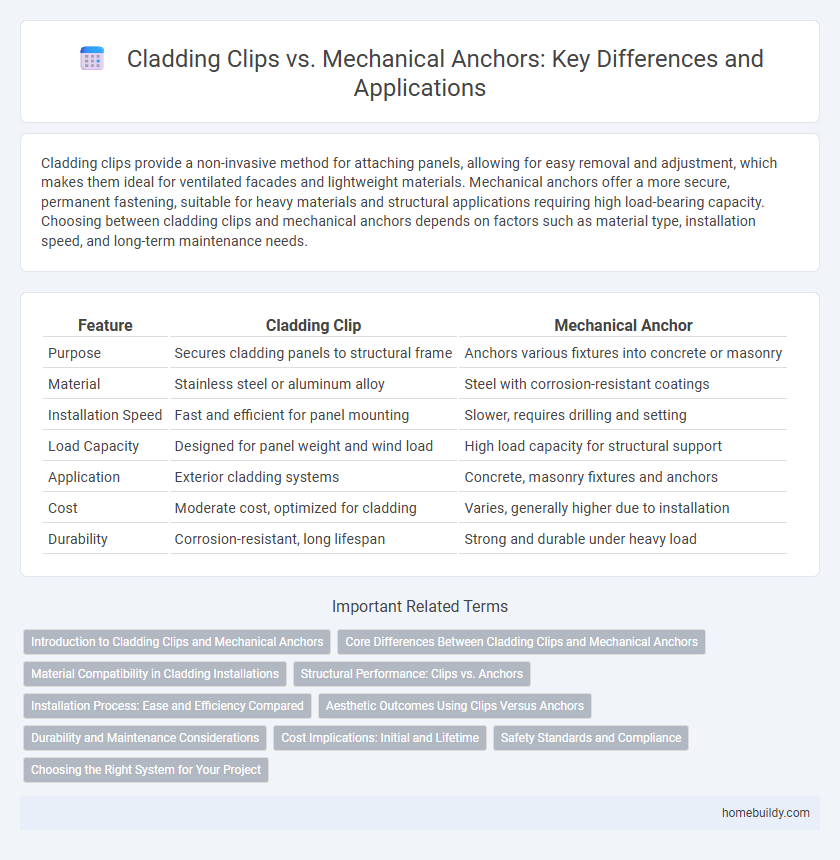Cladding clips provide a non-invasive method for attaching panels, allowing for easy removal and adjustment, which makes them ideal for ventilated facades and lightweight materials. Mechanical anchors offer a more secure, permanent fastening, suitable for heavy materials and structural applications requiring high load-bearing capacity. Choosing between cladding clips and mechanical anchors depends on factors such as material type, installation speed, and long-term maintenance needs.
Table of Comparison
| Feature | Cladding Clip | Mechanical Anchor |
|---|---|---|
| Purpose | Secures cladding panels to structural frame | Anchors various fixtures into concrete or masonry |
| Material | Stainless steel or aluminum alloy | Steel with corrosion-resistant coatings |
| Installation Speed | Fast and efficient for panel mounting | Slower, requires drilling and setting |
| Load Capacity | Designed for panel weight and wind load | High load capacity for structural support |
| Application | Exterior cladding systems | Concrete, masonry fixtures and anchors |
| Cost | Moderate cost, optimized for cladding | Varies, generally higher due to installation |
| Durability | Corrosion-resistant, long lifespan | Strong and durable under heavy load |
Introduction to Cladding Clips and Mechanical Anchors
Cladding clips provide a durable and flexible fastening solution for exterior cladding systems, ensuring secure attachment while accommodating material expansion and contraction. Mechanical anchors, on the other hand, offer robust load-bearing capacity by penetrating substrates and providing direct mechanical fixation. Both components are essential in facade construction, with cladding clips emphasizing ease of installation and adaptability, whereas mechanical anchors focus on strength and stability.
Core Differences Between Cladding Clips and Mechanical Anchors
Cladding clips provide a secure attachment system specifically designed for facade panels, allowing for hidden fastening and enabling thermal expansion and contraction without compromising structural integrity. Mechanical anchors, on the other hand, focus on penetrating substrates like concrete or masonry to offer direct load transfer and high tensile strength, but do not accommodate movement as effectively as cladding clips. The core difference lies in cladding clips' flexibility and aesthetic integration versus the mechanical anchors' robust, load-bearing capacity for structural anchoring.
Material Compatibility in Cladding Installations
Cladding clips offer superior material compatibility compared to mechanical anchors by minimizing direct contact between dissimilar metals, reducing the risk of galvanic corrosion. These clips are often made from corrosion-resistant materials such as stainless steel or aluminum, ensuring long-term durability in diverse cladding applications. Mechanical anchors may cause accelerated wear or damage when used with certain metals, making cladding clips a more reliable choice for preserving structural integrity.
Structural Performance: Clips vs. Anchors
Cladding clips offer superior flexibility in accommodating thermal expansion and building movements compared to mechanical anchors, reducing the risk of structural damage. Mechanical anchors provide robust load-bearing capacity but can induce stress concentrations on cladding panels, potentially leading to cracks or deformation. The choice between cladding clips and mechanical anchors significantly impacts the structural performance and longevity of facade systems.
Installation Process: Ease and Efficiency Compared
Cladding clips offer a streamlined installation process with fewer components compared to mechanical anchors, reducing labor time and the need for specialized tools. Their design allows for quick attachment and adjustment, enhancing on-site efficiency and minimizing installation errors. Mechanical anchors often require precise drilling and torque application, which can prolong installation and demand higher skill levels.
Aesthetic Outcomes Using Clips Versus Anchors
Cladding clips provide a cleaner, more streamlined aesthetic by remaining concealed behind the panels, eliminating visible fasteners common with mechanical anchors. This hidden fastening system preserves the architectural integrity and smooth surface appearance of facades. Clips also reduce shadow lines and surface disruptions, enhancing the overall visual uniformity compared to the bulky, exposed nature of mechanical anchors.
Durability and Maintenance Considerations
Cladding clips offer superior durability compared to mechanical anchors due to their corrosion-resistant materials such as stainless steel and aluminum, ensuring long-term performance in harsh weather conditions. Unlike mechanical anchors, cladding clips require minimal maintenance since they allow for thermal expansion and contraction, reducing stress on facade panels and preventing damage over time. The reduced need for regular inspections and repairs with cladding clips significantly lowers maintenance costs and enhances building longevity.
Cost Implications: Initial and Lifetime
Cladding clips generally offer a lower initial cost compared to mechanical anchors due to simpler installation and reduced labor requirements. Over the lifetime of the building, cladding clips can minimize maintenance expenses because they allow for easier panel replacement and adjustment, unlike mechanical anchors which may require specialized tools and additional labor for repairs. Cost implications also include potential savings from faster installation times and reduced material waste associated with cladding clips.
Safety Standards and Compliance
Cladding clips offer enhanced safety by ensuring secure attachment while minimizing thermal bridging, adhering to stringent EN 13658 safety standards for curtain walling systems. Mechanical anchors meet safety standards such as ASTM E330 but may introduce stress points that affect structural integrity over time. Compliance with ISO 14001 environmental management standards is more readily achievable with cladding clips due to their corrosion-resistant materials and ease of installation.
Choosing the Right System for Your Project
Cladding clips provide a flexible and efficient solution for attaching facade panels with reduced thermal bridging and easier installation compared to mechanical anchors. Mechanical anchors offer superior load-bearing capacity and are ideal for heavy or high-wind load applications, ensuring long-term structural integrity. Selecting the right system depends on project requirements such as panel weight, environmental conditions, and installation speed, optimizing both performance and cost-effectiveness.
cladding clip vs mechanical anchor Infographic

 homebuildy.com
homebuildy.com